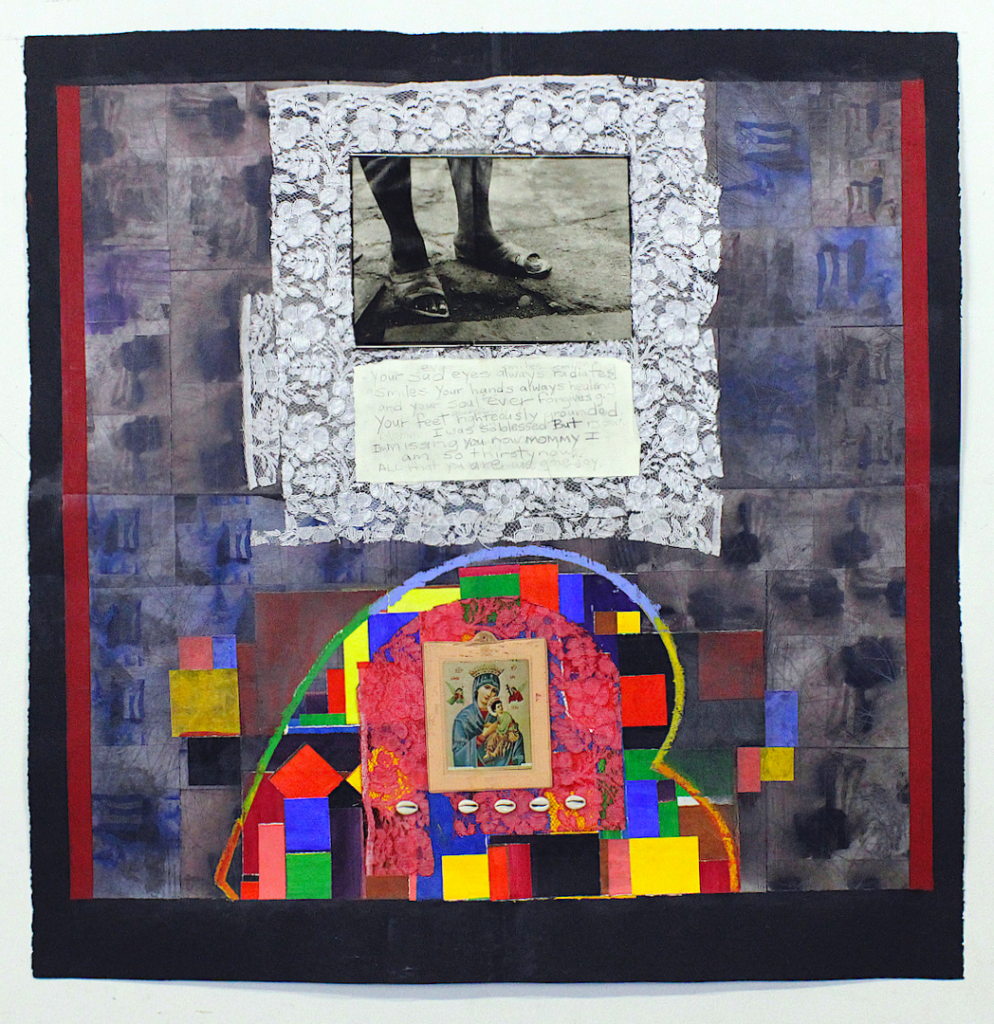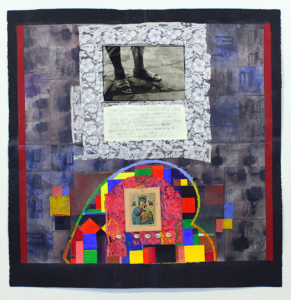So many things are familiar to me in this image: the chanclas, a staple of my childhood, for instance. A shoe that isn’t a shoe at all. In my house we could not go out in them, except to the beach. They were tropical footwear, but also, somehow, poor people’s footwear. They could create a case of mistaken identities. In the estampita (holy card?) on this collage I recognize the Virgin of Perpetual Succor. My grandmother had a great big stack of them she used daily in prayer. Photography, that ever-present altar to memory and family, also strikes a chord, although the image of a black woman’s feet certainly challenges traditional notions of representation. And then there’s the grid. I spent years hearing my professors explain how it flattened pictorial space, made everything equivalent, abolished illusionism, and perpetuated abstraction.
Many things in this image mark a distance from me. The cowrie shells are a good example. I know they were meant for good luck and were also a symbol of wealth in Africa and are related to the sacred (Farris Thompson 1983). But this is knowledge, not recognition. The photographs that make up that oh so familiar grid are pictures of a woman (the artist’s wife) with a naked torso whose face is obscured by the Puerto Rican flag. This is another item that is strange, not the flag, but the urgency in its repetition (Zavala 2023). And then there’s the poem. The one at the heart of the painting, with a lopsided heart outline. It is hand-written in a childish script with words that hover, as if the poet were unsure. Uncertainty is certainly familiar to me, but it was written in English, a language which stands apart from my childhood.

Poema para Mami: Missing You is a mixed media collage created with paper, acrylic paint, and oil paint on paper in 2013 by Juan Sánchez, an artist with an extraordinarily long and distinguished career. Born in Brooklyn in 1954, he evaded the fate of many of his classmates who were sent to trade schools. He received a BFA from Cooper Union in 1977 and an MFA from Rutgers in 1980. A participant of the vibrant Nuyorican cultural scene of the 1970s and 80s, he has exhibited widely and has left a legacy both through his artwork and through his role as educator at Hunter College. Recently Arlene Dávila remarked:
Ironically, Juan Sánchez is not well known in Puerto Rico’s art world. His work has seldom been exhibited there, like scores of Nuyorican and diasporic artists — especially Black artists such as Sánchez — who are invisible to archipelago art circles. These blinders erase the contributions of a visionary artist who has been consistent in his critique of the archipelago’s colonial condition, and of the fallacies of capitalism and commercial culture that prey on it. (Dávila 2022)
She’s right; it is only lately that his work has been incorporated in Puerto Rican museum collections and exhibitions. Yet, for me, Poema para Mami breaches the gap between a Nuyorican experience, lived at the crossroads between languages and cultures, and Puerto Rican experience to which Dávila ascribes the concept of “national privilege” or a sense of an elite identity associated to language, class and race, a concept she develops in her book Latinx Art (Dávila 2020). And it does so precisely by focusing on commercial culture, while focusing on collage as an artform that foregrounds fragmentation and juxtaposition, fostering a sense of precariousness.
Sánchez’s focus on the object is one of the elements through which this image bridges the divides between diasporic and island experience. The objects—represented or physically present in the picture (I’ve yet to mention two pieces of lace placed at the work’s center)—exude a sense of fragmentation that is resonant to a history filled with interruptions cultural, political, and personal. Each item is burdened with connotations that signal a connection to the domestic: the estampita to the bedside shrine the artist remembers in his mother’s room, the lace to an idea of femininity entrenched in the home. Yet these familiar objects generate different readings when placed alongside the cowrie shells that tie together Catholicism, the slave trade, and syncretism and create an archipelagic vision of identity. A similar thing happens to the lace which, placed directly beneath the photograph of his mother’s feet, generates an expanded notion of the feminine. In the poem at the artwork’s center, Sánchez speaks of the feet being grounded, signaling the outsize role of women in urban life. By choosing commercially available objects with a strong affective charge, the artist unleashes a sense of recognition and kinship that goes beyond “national privilege”. In fact, many Puerto Rican artists have also used objects to tell the truncated stories of their identities: Antonio Martorell wrote a visual memoir in fragments titled La piel de la memoria (1991) and Myrna Báez enshrined her middle-class identity through her representation of a dining room presided by a Tiffany lamp in the painting of the same name, while Millie Arango created domestic shrines of repurposed objects that blended Catholicism and feminine identity. Objects, the debris of our capitalist/colonial relationship, become totems that reaffirm memory and identity.
What is the pull of objects? In his interview for the Archives of American Art with Josh Franco, Sánchez reminisced about his intense linguistic difficulties growing up:
But my point is that you talk about these bubbles, these communities, where the painted signs are all in Spanish, the pharmacy is in Spanish, everybody speaks Spanish, and outside of that neighborhood—or, let’s say, entering into another bubble, which is going to school, where, okay, it was English, that was what was going on.
In a way, that gave me, as well as a lot of other people from my generation, great difficulty, because it was like a schizophrenia where it got to the point where relatives—my parents were like, ‘No, he doesn’t speak Spanish’ or whatever, you know, and at the same time, outside of that environment, I spoke this terrible English and I didn’t understand what the fuck was being said and I was always behind in my reading level. But throughout all of that, the one thing that kept me very engaged was drawing. (Franco 2018, p. 8)
In this world of linguistic uncertainties, objects become imbued with a sense of presence and power. Images do too. Perhaps this is why Sánchez so often recurs to photography: it encompasses the power of both object and image. Sánchez, who was fascinated by The Nuyorican Poet’s Café (1973) as much as by the photographic group En Foco (1974), tries to move beyond language (or grapple with it) in a work of art that explicitly takes its title from a literary form.
Objects, photographs, and fragmentation are central to Juan Sánchez’ works. Collage, that early twentieth century invention created to puncture the limits between art and everyday life, is the principal tool through which Sánchez tells stories, but also challenges narratives that exclude Afro Puerto Ricans, make class and gender invisible, or that marginalize certain urban spaces or certain political options from the world of art. In his works, collage is an instrument that speaks not so much of everyday life as of the omissions and occlusions of modernity, the dissimulation of its colonial underpinnings.
Retooling Modernism’s instruments is something that characterizes this artist’s work. A good example is his use of the grid. Tied to the world of geometric abstraction, it is also a tool that speaks of Sánchez’s history. Like many Puerto Ricans of his generation, Juan Sánchez was initially steered towards a “practical” career and began as an illustrator and commercial artist (Franco 2018). In the seventies, this required the use of the grid for lay-out purposes. Simultaneously, in galleries and museums, the grid meant high Modernism and non-figurative abstraction (Krauss 1979). In this collage Sánchez uses the grid to create a matrix for his images, much like Robert Rauschenberg used them in his combined paintings and prints (Steinberg 1972). Unlike Rauschenberg, who culled his images from the news and random print imagery, Sánchez’ imagery is deeply personal, overlaid with affect. The artist reveals the tension between the figure and abstraction in the lower third of the artwork Poema para Mami. There, brightly colored squares, and rectangles deliberately recall geometric abstraction, a la Ellsworth Kelly. The background, however, is made up of photographs that insist on Puerto Rico’s nationalist struggles since the photographs of his wife and the Puerto Rican flag were made to protest the prison sentence of prominent nationalists (Zavala 2023). Foreground and background create competing narratives around the grid: bright, formal, pure in the foreground and figurative, political, nationalist in the background. This juxtaposition unmoors the grid’s claims to purity. In Juan Sánchez’s collage, abstraction is narrative, personal (imbued with his history as a graphic designer using the grid as a tool), racial, political, and deeply symbolic.
Poema para Mami is a work of art that speaks of the artist’s experience as a black Puerto Rican man in New York and his profound love for his mother, Carmen María Colón. A collage, full of fragments and objects that speak of race, class, and the urban environment, it is a work that builds bridges between island experiences. Anchored in the grid, it challenges the grand narratives of abstraction. It is also a work of art that puts on display the power of family in our experiences, both Diasporican and Puerto Rican. The poem at the center of the work of art, the poem that gives the work its title, reads:
Your sad eyes always radiates (d)
Smiles. Your hands always heal(ing)
And your soul (for)ever
Forgives (ing). Your feet (always) righteously grounded
I was (am) so blessed But (now)
I’m missing you now mommy I
Am so thirsty now
All that you are is (was) gone (the) joy.
Juan Sánchez’s Poema para Mami recaptures the power of collage as an artform. The format, with its fragmented structure, connects to Puerto Rico’s colonial history and creates points of contact for viewers like me, with a completely different history and experience. The work of art powerfully challenges abstraction’s grand narratives by implicating its silences with political (and social, racial, and gender) violence.
References
- Dávila, Arlene. 2020. Latinx Art: Artists, Markets, Politics. Durham, NC: Duke University Press.
- Dávila, Arlene. 2023. “Juan Sánchez’s Nuyorican State of Mind.” Hyperallergic. Accessed October 17, 2024: https://hyperallergic.com/772248/juan-sanchez-nuyorican-state-of-mind/.
- Farris Thompson, Robert. 1984. A Flash of the Spirit. Visalia, CA: Vintage Press.
- Franco, Josh T. 2018. Oral History Interview with Juan Sánchez October 1-2. Smithsonian Archives of American Art. Accessed on October 17, 2024: https://www.aaa.si.edu/collections/interviews/oral-history-interview-juan-snchez-21975.
- HM&C Study Room: an in-depth look at Juan Sánchez. Hutchinson Modern & Contemporary. Accessed on January 3, 2025: https://hutchinsonmodern.com/viewing-room/17-juan-sanchez-ricanstructions-condiciones-que-existen/.
- Krauss, Rosalind. 1979. Grids. October vol. 9: 50-64.
- Martorell, Antonio. 1991. La piel de la memoria. San Juan, PR: Editorial de la Universidad de Puerto Rico.
- Poema Para Mami: Missing You, Object Details. National Museum of African American History and Culture. Accessed January 3, 2025: https://www.si.edu/object/poema-para-mami-missing-you%3Anmaahc_2021.71.2.
- Steinberg, Leo. 2007. “The Flatbed Picture Plane.” In Other Criteria: Confrontations with 20th Century Art. Chicago, IL: University of Chicago Press.
- Zavala, Adriana. 2023. Juan Sánchez’s Counter-Intuitive Archive. American Art 37 (2): 54-81.
